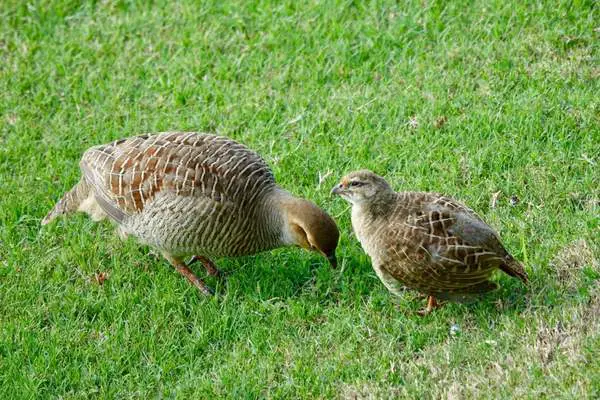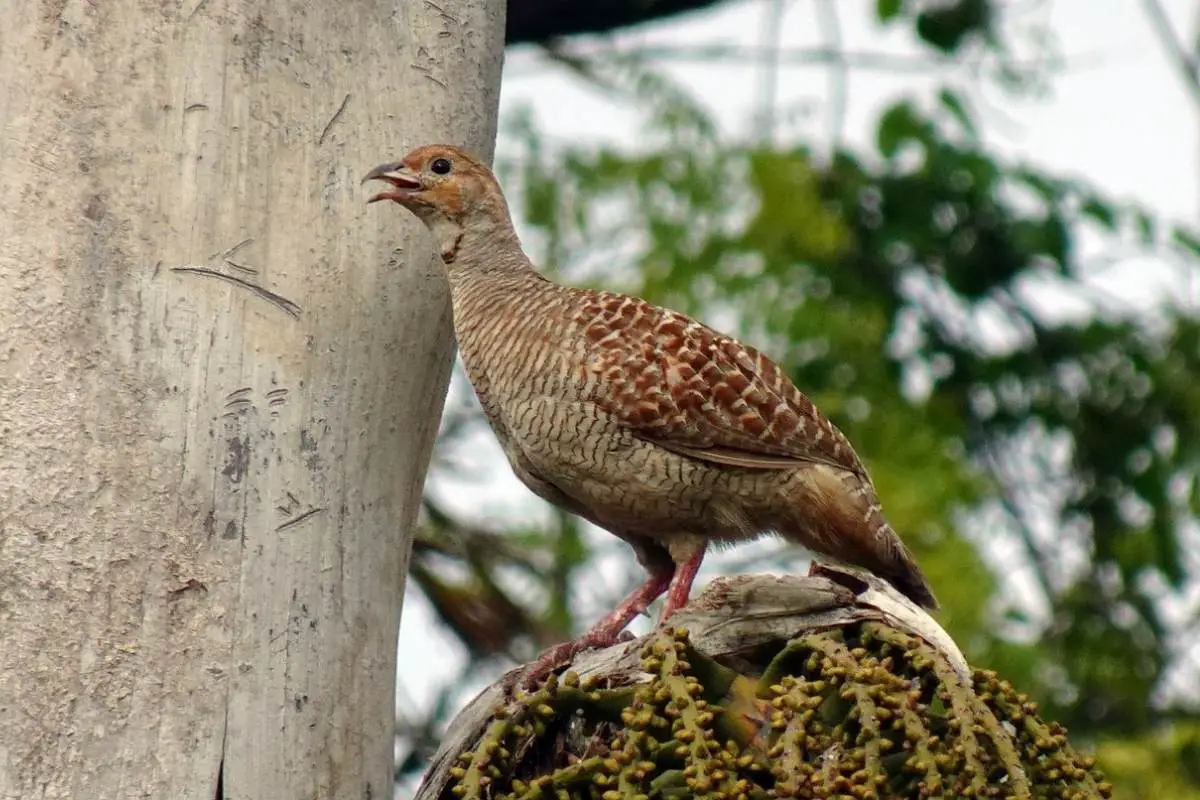Common Name: Gray Francolin
Scientific Name: Ortygornis pondicerianus| Size | Diet | Range in Hawaii | Status in Hawaii |
|---|---|---|---|
| 11.6 in. - 13.4 in. | grass and weed seeds, cultivated grains, buds, flowers, leaves, rhizomes, fruits and berries | Hawaiian Islands | least concern |
Gray francolins are one of the francolin species found in Hawaii. They were brought to the state to be hunted as game birds but originally came from South Asia. Since they originated in other countries, there is still much to be discovered about these amazing species.
Here is a brief overview of gray francolins’ appearance as well as some of the information you need to know about them.
Gray francolin

Scientific Name: Ortygornis pondicerianus
Appearance
Male Gray francolins are larger than females and range in size from 30-32cm. It has a grayish-brown body, a stubby tail, and a dark border patch around the neck. The border patches are more visible on mature adults than on young birds.
They also have orange cheeks, throats, and foreheads, but the northern and northwest races have white throats and are paler in color than the southern races. Aside from their sizes, males and females can be distinguished by the visible mark on their throats. The male throat has an anchor-shaped black mark that females don’t have.
Diet
Gray francolins are omnivores, which means they eat both plants and animal matter. They primarily consume seeds, fruit, and leaves, but they also consume insects, such as termites and beetles of all stages.
Like all other birds, Francolins require protein in their diet, which insects provide. However, they’re mostly seen feeding on seeds, fruits, leaves, shoots, buds, and even flowers, which are plentiful in Hawaii at all times of the year.
Behavioral traits
Gray francolins are typically found in small groups. They’re extremely shy and will flee if they see a human approaching them. These species can be found searching for food on grassy or bare ground in open country and scrubs.
The birds use a loud call to communicate with other birds in their group, especially during mating season, when males and females use their call to attract each other. These animals are also known to duet with their mated pairs, which can be heard frequently, particularly in the morning.
Breeding

The breeding season for gray francolins lasts from April to September. Nests are built and hidden on the ground in low shrubs or trees, and eggs are laid there as well. The female lays three to eight eggs at a time, which she incubates for 18 to 19 days before hatching.
While the female is incubating, the males are in charge of warning when danger is approaching. Chicks are precocial and can feed themselves shortly after hatching. These birds can breed within a year of hatching and are monogamous, which means they only have one mate for the rest of their lives.
Habitat
These birds prefer dry and open grasslands, avoiding forests and humid areas the majority of the time. They can be found in thorny scrubs and savannahs, where they hunt for food during the day. Gray francolins can also be found along highways, golf courses, lawns, and even along the edges of forests, where their food supply is widely available.
Native
Even though gray francolins have a very wide range, they’re actually indigenous to the arid regions of South Asia, particularly in Iran, Pakistan, India, Bangladesh, and Sri Lanka. They stay away from areas with high elevations, and as shy birds, they prefer undisturbed environments.
Hawaii
Humans introduced this species to the island chain as additional gamebirds during the 1950s. They have been able to thrive and multiply exponentially since their introduction over two centuries ago. These birds can now be found on the various islands of Hawaii, particularly in the drier lowlands of most Southeastern Hawaiian Islands.
You can find them in dry areas like shrublands, grasslands, roadside ditches, and even coastal kiawe forests. They can also be seen at sea levels of up to 3,280 meters.
Conservation Status
Despite being hunted as gamebirds on the island of Hawaii, Gray francolins are currently listed as the least concern on the IUCN Red List of Threatened Species, indicating that extinction isn’t a concern.
These birds thrive in their natural habitats on the island of Hawaii, where they’re hunted as game birds. They’re also being studied for research purposes.
Interesting facts
1. They’re gamebirds
Gray francolins are one of the frequently encountered gamebirds in Hawaii. These birds can be hunted for sport or food and have been found on Kaua’i, O’ahu, Maui, Moloka’i, Lana’i, and the big island of Hawai’i.
2. They have a loud call
Gray francolins are very vocal birds, and their calls are an important part of this species’ breeding process. The male gray francolin call is made up of distinct notes that sound like kat-ee-la kat-ee-la kat-ee-la. Females, on the other hand, have tee-tee-tee high-pitched notes.
When they’re threatened, they’ll also make a sharp kirr-kirr sound.
3. Gray francolins were introduced to the mainland US but failed to thrive
Gray francolins were introduced to the mainland United States in the 1960s and were expected to thrive in their new environment. Instead, they failed to establish a population and thrived only on the Hawaiian islands.
4. Also known to eat snakes
Apart from its regular diet of seeds, fruits, termites, and other insects, this species is also known to prey on tree snakes and small lizards such as geckos and sand lizards.
5. Birds of this species are weak fliers
They have short, rounded wings with a wingspan of 14-16 inches and don’t fly as high as other birds. They only fly when necessary, such as to escape predators or cross wide open spaces, and only for short distances. Running is the gray francolin’s preferred mode of locomotion, which it does with grace and speed.
Frequently asked questions:
What can I feed gray francolin?
Gray francolins are omnivorous, eating seeds, grains, fruits, and insects. They get their protein from insects, so adding them to their diet is highly encouraged.
Where do Francolins nest?
Gray Francolins build their nests on the ground, usually in tall grasses and bushes.
How many eggs does gray francolin lay?
These birds lay four to ten eggs during the breeding season, which occurs in April and May.
Is a francolin a quail?
As members of the Phasianidae family, quail and francolins are closely related but distinct from one another.




